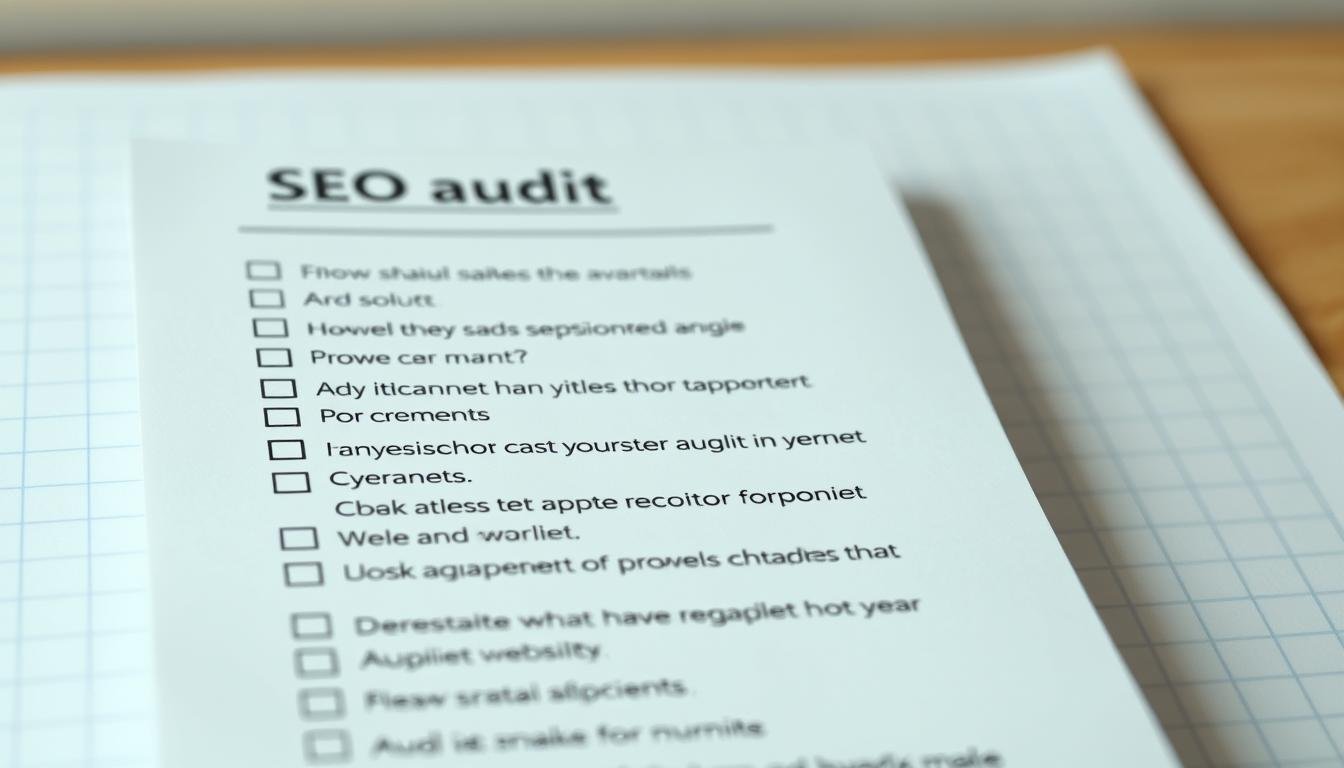I’ve spent many nights looking at analytics, watching websites try to get better in search rankings. It’s frustrating to see them miss out on potential visitors. A detailed website SEO checklist is crucial for online success.
When I started learning about search engine optimization, I found out a website seo checklist can make a big difference. It’s not about quick fixes. It’s about doing a deep analysis to find new chances.
This SEO audit checklist for websites will guide you to better online visibility. We’ll cover all important parts of website optimization, from technical stuff to content strategy. My aim is to give you a clear, useful guide to make search engine optimization easier to understand.
Key Takeaways
- A comprehensive SEO audit is essential for improving website performance
- Systematic analysis reveals hidden optimization opportunities
- Website SEO checklist covers technical, content, and user experience factors
- Regular audits help maintain and improve search engine rankings
- Optimization is an ongoing process, not a one-time task
Understanding the Importance of SEO Audits
Digital marketing changes fast, making a detailed seo website audit key for success online. My work as a digital strategist shows that websites need regular updates to keep up in search rankings.
An SEO audit checks how well your website does in search engines. It finds issues that stop your site from being seen and ranked better.
What is an SEO Audit?
An SEO audit looks at many things that affect how well a website does in search engines. It’s a deep dive into:
- Technical website setup
- How good and relevant your content is
- How users feel when they visit your site
- Who links to your site
Why Conduct an SEO Audit?
“Knowledge is power in digital marketing, and an SEO audit provides that knowledge.” – Digital Marketing Expert
Regular audits are good for businesses because they:
- Find and fix problems
- Boost search rankings
- Make the site better for users
- Bring in more visitors
Frequency of SEO Audits
How often you should do an audit depends on your website and your field. Here’s a suggested plan:
| Website Type | Audit Frequency |
|---|---|
| Small Business Website | Quarterly |
| E-commerce Platform | Bi-monthly |
| Large Corporate Site | Monthly |
Being proactive with your seo website audit keeps your online presence strong and competitive.
Initial Setup for Your SEO Audit
Getting ready for an SEO audit needs careful planning and the right tools. I start by making a detailed website audit checklist. This begins with knowing the key resources and setting clear goals.
Essential Tools for Your SEO Audit
Choosing the right tools is vital for your SEO audit. I suggest using a mix of free and paid tools for a strong SEO audit template:
- Google Analytics for website traffic analysis
- Google Search Console for search performance insights
- Specialized SEO software like Semrush or Ahrefs
- Screaming Frog for technical website crawling
- PageSpeed Insights for performance evaluation
Setting Strategic Audit Goals
Setting clear goals is key for a successful SEO audit. Your objectives should be specific, measurable, and match your digital marketing strategy. Focus on these main areas:
| Goal Category | Specific Objectives |
|---|---|
| Performance Improvement | Increase organic search rankings by 20% |
| Technical Optimization | Reduce page load time by 2 seconds |
| Content Enhancement | Identify and fill 5 content gaps |
By picking the right tools and setting clear goals, you’ll have a solid SEO audit plan. This plan will help improve your website’s search performance.
Technical SEO Analysis
Technical SEO analysis is key in a website audit template. It’s part of the SEO checklist for website optimization. I’ll show you the important technical parts that boost your site’s search engine ranking.
Technical SEO is more than just content. It’s about the site’s structure and how it works. This affects both search engine visibility and user experience.
Website Performance and Speed
Site speed is vital for search rankings. Use tools like Google PageSpeed Insights to check your site’s speed. Focus on these areas:
- Minimizing server response times
- Optimizing image sizes
- Leveraging browser caching
- Reducing unnecessary code
Mobile Responsiveness
With mobile-first indexing, your site must work well on mobiles. Google favors mobile-friendly sites in search results. Check these points:
- Responsive design across all device sizes
- Touch-friendly navigation
- Readable text without zooming
- Fast mobile loading times
HTTPS Security
Website security is now a must. An SSL certificate protects user data and helps with search rankings. HTTPS offers:
- Enhanced user trust
- Improved search engine rankings
- Protection against data breaches
- Better overall website credibility
By fixing these technical SEO issues, you’ll strengthen your website’s search performance and user experience.
On-Page SEO Evaluation
Creating a strong website seo checklist means diving deep into on-page optimization. On-page SEO turns your web pages into search engine magnets.
Mastering Title Tags and Meta Descriptions
Your title tags and meta descriptions are like digital billboards. They should be:
- Concise and compelling
- Accurately represent page content
- Include primary keywords naturally
- Stay within recommended character limits
*Precision in meta content can dramatically improve click-through rates*
Structuring Content for Maximum Impact
A detailed seo audit checklist for websites needs careful content organization. Use header tags (H1, H2, H3) to create a clear content hierarchy. This helps both users and search engines.
Keyword Optimization Techniques
Using keywords effectively is more than just repeating them. I suggest:
- Integrating keywords naturally
- Focusing on user intent
- Avoiding keyword stuffing
- Using semantic variations
By using these on-page SEO strategies, your content will appeal to both search algorithms and readers.
Off-Page SEO Factors
When doing a detailed seo website audit, off-page SEO is key. It shows how your website is seen online. These outside factors greatly affect your search rankings and how visible you are online.
Off-page SEO is about building trust and authority from outside your site. My seo checklist for website optimization includes several key strategies to boost your online presence.
Backlink Profile Analysis
Looking at your backlink profile helps see the quality and number of links to your site. I suggest using top tools to check these important details:
- Check total number of backlinks
- Assess domain authority of linking sites
- Identify potentially harmful links
- Discover opportunities for link building
Social Media Influence
Social signals are getting more important in SEO. Engagement metrics can help improve your search rankings. They make your brand more visible and bring in more traffic.
Brand Mentions and Reputation
Managing your online reputation is vital for SEO success. Search engines watch brand mentions everywhere, even without direct links. Good mentions can really help your site’s credibility and rankings.
- Monitor brand mentions
- Engage with online communities
- Respond to customer feedback
- Create shareable, high-quality content
Content Quality and Relevance
When we do a website audit checklist, content quality is key for SEO success. Search engines love websites with valuable, engaging content. This content should meet user needs and expectations.

My method for checking content involves a detailed seo audit template. It looks at how well content works in many ways.
Assessing Current Content
To evaluate your content, start by checking it against these important points:
- Is it relevant to your target audience?
- Does it provide deep information?
- Is it clear and easy to read?
- Does it match your target keywords?
Content Gaps and Opportunities
Finding content gaps needs careful research. Look for topics your competitors cover that you haven’t addressed. Use tools like Google Search Console and keyword research platforms to find new content ideas.
User Engagement Metrics
Measuring how users interact with your content is important. Look at these metrics:
- Average time on page
- Bounce rate
- Social shares
- Comments and interactions
By checking these areas, you can create high-quality content. This content will be good for search engines and connect with your audience.
User Experience (UX) Assessment
Creating a great user experience is key for your website’s success. When making a detailed seo analysis checklist, UX is very important. It shows how visitors use your website. I focus on making every part of user interaction better.
A good seo audit checklist needs a deep UX check. Let’s look at the main parts:
Website Navigation and Structure
Your website’s layout should be easy to use. I suggest:
- Clear and simple menu structures
- Easy navigation paths
- Consistent design on all pages
- Quick access to key content
Effective Calls-to-Action (CTAs) and Conversion Paths
Well-placed CTAs boost user interaction. Here are some tips:
- Make CTA buttons stand out
- Use action words
- Place CTAs where they’re easy to see
- Make conversion paths clear
Accessibility Considerations
“Great design is accessible design” – Steve Krug
Accessibility is more than a law—it’s essential for a good user experience. Focus on:
- Screen reader support
- Good color contrast
- Keyboard navigation
- Image alt text
By using these UX tips, you’ll make a website that’s fun, accessible, and good for search engines. It will meet your digital marketing goals.
Local SEO Considerations
Local SEO is key for businesses aiming at specific areas. It boosts visibility and draws in local customers. This is done through smart digital marketing.

Local search needs a detailed plan, not just basic SEO. Let’s explore the main steps to improve your online presence.
Google My Business Optimization
Getting your Google My Business profile right is crucial. Here’s what to do:
- Verify your business location
- Add accurate contact information
- Upload high-quality business images
- Select precise business categories
Local Citations and Listings
Having the same info everywhere online builds trust. Make sure to keep track of your local citations for accuracy.
Customer Reviews and Engagement
Reviews are vital for local search rankings. Here’s how to handle them:
- Encourage happy customers to review
- Respond well to all feedback
- Check review sites often
By using these local SEO strategies, your business will shine in local searches. It will also attract more customers.
Reporting and Results
After finishing a detailed website audit checklist, the next step is to turn your SEO insights into real actions. My experience shows that good reporting can greatly boost a website’s performance and its ranking on search engines.
To make a useful SEO checklist for website analysis, focus on key performance indicators. These show how well your digital marketing is doing.
Key Metrics to Track
When you’re checking your website audit checklist, pay attention to these important metrics:
- Organic search traffic volume
- Keyword ranking positions
- Conversion rates
- Page load speeds
- Bounce rates
Interpreting Audit Results
Understanding your data is more than just looking at numbers. Contextualizing metrics helps spot real chances for website betterment. Look for patterns that show how you can improve user experience and search engine visibility.
Recommendations for Improvement
After looking at your audit findings, make a plan of action. Start with quick, impactful changes that can quickly improve your website’s SEO.
- Fix technical SEO issues first
- Make underperforming content better
- Speed up your site and make it mobile-friendly
- Get high-quality backlinks
Remember, an SEO audit is not just a one-time thing. It’s an ongoing effort to keep getting better and adapting.
Continuous Improvement
SEO is always changing, needing constant attention and updates. I’ve learned that successful digital marketing is about ongoing optimization, not just a one-time check. Keeping your website up-to-date is key to staying on top of search engines.
Having a regular review schedule is essential for SEO success. I suggest doing a detailed SEO analysis for your website every three months. This helps you see small changes, spot new trends, and fix any optimization issues fast. Regular checks keep you ahead of search engine updates and changes in the market.
Being part of professional SEO groups is very helpful. Sites like Search Engine Journal, Moz forums, and webinars are great for learning. They let you share ideas, learn from others, and understand complex SEO challenges better.
To keep up with SEO trends, you need to keep learning and be flexible. I spend time reading top blogs, going to marketing events, and taking online courses. This keeps my strategies fresh and effective, helping your website get more visitors.


